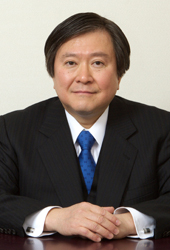Messages
TAKAGI Kuninori, M.D., Ph.D. IUHW Chairman
The university is entering a new stage of growth amid the 30th anniversary celebration

The International University of Health and Welfare opened in Otawara City, Tochigi Prefecture, in 1995 as Japan's first comprehensive university of health and welfare. In 2025, the university celebrates its 30th anniversary, marking a significant milestone.
With the founding spirit of "the realization of a society where people live together”, the university has set a major goal of improving the status of medical and welfare professionals, as well as nurturing leaders in these fields in Asia. Since its opening, the university has provided education led by experts in the medical and welfare fields. Currently, the university has 11 faculties, 28 departments and a graduate school across five campuses nationwide, covering nearly all medical and welfare fields. Approximately 10,000 students study at the university, which has produced about 37,000 excellent graduates to date. The university boasts one of the highest national exam pass rates and employment rates, and has come to be regarded as one of the most successful private universities established after the war.
One of the major features of our university is its state-of-the-art learning environment. Six affiliated hospitals and group-related facilities are positioned as clinical medical research centers that fully cooperate with education and research, providing an environment in which students can learn about "team medical care and team care".
Every year, about 1,000 students participate in overseas training to experience medical and welfare sites around the world. We also offer scholarships to international students, primarily from Asia, to educate future leaders in the medical and welfare fields in their home countries. This international approach to education is another feature of our university.
Our five campuses across the country make use of the characteristics of each region to educate excellent medical and welfare professionals.
In the Tochigi region, centered on the Otawara Campus, where the university was founded, our group-related facilities occupy a vast site of about 500,000 m2, equivalent to 10 Tokyo Domes. The Otawara Campus houses six medical and welfare facilities, including a disability support facility, a rehabilitation facility, the only child psychological treatment facility in Tochigi Prefecture, and a clinic. In addition, the Nasu-Shiobara area is home to the International University of Health and Welfare Hospital, a nursing home for the elderly, and a special nursing home where students can come into contact with the elderly people and people with disabilities. There are also welfare, sports, and cultural exchange facilities that can be used for training.
The Okawa Campus is adjacent to Takagi Hospital, the group's original hospital with a history of over 110 years. It is also linked to Yanagawa Rehabilitation Hospital, one of the largest in Japan and located in Yanagawa City. This makes the Okawa Campus an ideal educational environment for training medical professionals to develop practical skills.
The Odawara Campus has a main school building adjacent to Odawara Station and another school building on the grounds of Odawara Castle, a popular tourist attraction. The campus has a training system that cooperates closely with the International University of Health and Welfare Atami Hospital.
The Tokyo Akasaka Campus is located in the heart of Tokyo, just a three-minute walk from Akasaka-Mitsuke Station. It will develop education linking undergraduate and graduate schools and function as a hub for medical and welfare exchange.
The Narita Campus is located in the international city of Narita and has many international students, including 120 students in the School of Medicine. It is integrated with the International University of Health and Welfare Narita Hospital, which aims to become a leading hospital in Asia, providing a global learning environment for its students.
In April 2025, the Department of Medical Technology and Sciences opened at the Otawara Campus. This department will train medical laboratory technicians. It is the third department established, following the Okawa and Narita campuses. It is also the only department in the Tohoku region and Tochigi Prefecture that trains medical technologists at a four-year private university.
In the future, we will continue to collaborate with our affiliated hospitals and clinical medicine research centers to enhance our education, clinical practice, and research. We will also work to strengthen our role as a comprehensive medical and welfare university and train medical professionals in demand at home and abroad.




